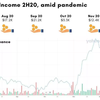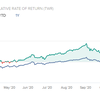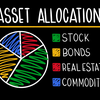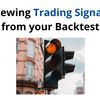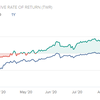The Ultimate Tool for Finding Top Breakout Stocks
Ed Seykota, one of the market wizards behind computerized systems trading, turned $5,000 into $15 million in 12 years.
He is a strong believer in trend following and uses a breakout trading system to enter trades when momentum is in his favour.
Whether you do day trading or swing trading, using a solid breakout trading system can significantly improve the risk reward ratio of your trades and increase your trading profits in the long run.
In this article, I’m going to introduce a tool that I built to help you identify top breakout stocks with explosive momentum.
What is a breakout in stocks?
A breakout in stocks occurs when the price of a stock breaks above its resistance level or breaks below its support level. After a breakout happens, prices tend to continue moving undeterred with strong momentum.
The example below shows Tesla breaking out from it’s 140 day high in November 2019 (highlighted in yellow) when it surged from $65 to almost $400 one year later.
You can think of the stock’s price normally acting as a ping pong ball bouncing between a glass floor (support level) and a glass ceiling (resistance level).
When the ball hits the floor, it rebounds off the floor which acts as a support. When the ball hits the ceiling it bounces off the ceiling which acts as a resistance.
However, what happens if this ping pong ball suddenly transformed into a bowling ball during mid flight?
If the bowling ball is falling towards the floor, it would smash right through the glass floor which offers little support against the bowling ball’s large momentum. Similar If the bowling ball is flying towards the ceiling, it will smash right through the glass ceiling which provides negligible resistance.
In the case of stocks, when investors get excited due to a positive earnings release for example, this enthusiasm provides the momentum for the stock price to break through its resistance level and surge towards new highs.
Conversely when investors start panicking due to a public health crisis such as Covid-19, the widespread fear across the market causes stock prices to crash through their support levels.
As a breakout swing trader or day trader, your goal is to identify such breakouts when they occur so that you can buy stocks that break above their resistance level and short stocks that break below their support level.
How do you trade breakouts?
The rules of a mechanical trend following trading systems are very simple.
-
Go long when the price breaks above the high of the past n days.
-
Go short when the price breaks below the low of the past m days.
The highest price of the past n days acts as the resistance level. If the stock’s price is able to break above this high price, it reflects strong upward momentum. This is a strong indicator that confirms a breakout into an uptrend.
Conversely the lowest price of the past m days acts as the support level. If the stock’s price is able to break below its low price, it is a strong indicator that confirms a breakout into a downtrend.
Let’s take a look at Apple. The chart below shows the price of Apple (blue line) sandwiched between 2 gray lines which act as the channel.
The gray line above the blue line is the resistance level based on the high of the past 20 days. The gray line below the blue line is the support level based on the low of the past 60 days.
The green arrow is an indicator to go long when the price hits the top gray line. The red arrow is a signal to short the stock when the price hits the bottom gray line.
The big question is what look back periods should we use?
The turtle traders, under the mentorship of Richard Dennis, used both a short term and a longer term lookback period for systems trading.
System 1 was a short term system based on a 20 day breakout while System 2 was a longer term system based on a 55 day breakout.
While this set of rules for systems trading were highly profitable for the turtle traders, backtest results have shown that when the same set of rules were applied many years later, the strategy was not as successful as before.
There are two possible reasons why the strategy did not perform well years many years later.
-
The breakout parameters for the lookback period are fixed at 20 days and 55 days. This is a problem because different instruments have different trends. Some instruments have short term trends while other instruments have long term trends. These trends could also change over time as well so it does not make sense to use a static look back period over the entire history.
-
The breakup parameter of 20 days is the same as the breakdown parameter of 20 days. There is no reason to assume that these parameters should be the same because in one case we are looking to enter a long trade while in the other we are trying to short the market.
Why is it important to pick the right indicator to confirm a breakout?
Picking the wrong stock breakout signal that fails to properly capture the trend can be detrimental to your strategy’s performance.
This is because if a stock is in a long term uptrend and we use a short look back period, there is a high chance that we might get whipsawed due to the volatility of the stock’s price.
For example, if we use a 120 day break up and 80 day break down window for Tesla, the plot below shows that a bad trade would be made in the part highlighted in yellow below. The system generated a sell signal in March 2020 anticipating that the stock will enter a down trend. However, the stock rebounded shortly after that, causing the trading system to miss out on the recovery after the Covid crash. If a longer term break down parameter was used, the sell signal would not have triggered because the gray line would have been lower, hence allowing more room for volatility.
What traders typically do to account for the volatility of the stock’s price when deciding their breakout parameters is to use the average true range (ATR) which is a measure of the market volatility over a given period of time.
However, this approach is subjective as well. There are different multiples of ATR which you could choose to set your stop loss. For short term trends, setting your stop loss at 1 X ATR might be more appropriate while for longer term trends, setting your stop loss further away at 2 X ATR might be better to avoid being whipsawed due to volatility.
How do we remove this subjective approach towards trading and instead rely on data analysis to select the optimal breakout parameters?
Finding the best stock breakout signals
The best approach is to backtest your trading strategy using different breakout parameters. This allows us to figure out which breakout parameters are the most profitable and are able to generate trades with the highest risk reward ratio.
To help you out, I’ve created a tool that runs 100 backtests using different breakup and breakdown parameters. This is how you use it.
First head over to https://pyinvesting.com/trading-breakouts/.
Fill in the form below specifying the stock you are interested in. In this example we are going to look at Apple.
Next select your start and end date for the optimization. The start date by default is chosen to be 5 years ago and the end date is set as today’s date.
Select the performance metric that you would like to use to determine which is the best breakout trading parameter. By default, the Sharpe Ratio is used which allows us to find out which breakout parameters lead to the highest risk adjusted returns of our trading strategy.
Finally hit the blue button to start trading breakouts.
The results will show a heat map where each square represents the results of running a backtest with a specific breakout parameter. The greener the square, the better the performance would be based on our selected performance metric (Sharpe Ratio).
The results show that the Sharpe Ratio generally improves as the breakup lookback period gets shorter. On the other hand, there is no clear pattern for the breakdown parameter in affecting the trading strategy’s performance.
If you click on any of the squares, it will show you the backtest results using the respective parameters. For example, here are the results from the 20 day breakup and 60 day breakdown window. Based on these parameters, the latest signal generated by the trading system was a buy signal in April when the markets rebounded from the Covid crash and broke into an uptrend.
Scrolling down we can see the profit and loss (P&L) of trading Apple using the 20 day breakup and 60 day breakdown parameters along with performance numbers such as total returns, Sharpe Ratio and max drawdown.
Conclusion
Breakout trading can be highly profitable if we are able to catch onto a major trend. However, finding the best stock breakout signals is crucial as it prevents us from being whipsawed due to price volatility. We discussed how we can improve our risk reward ratio by running multiple backtests with different parameters to find the optimal parameters for our breakout trading strategy.
Now head over to https://pyinvesting.com/trading-breakouts/ and find out the best trading system for your favourite stocks today.
Happy investing and may the odds be in your favour.


